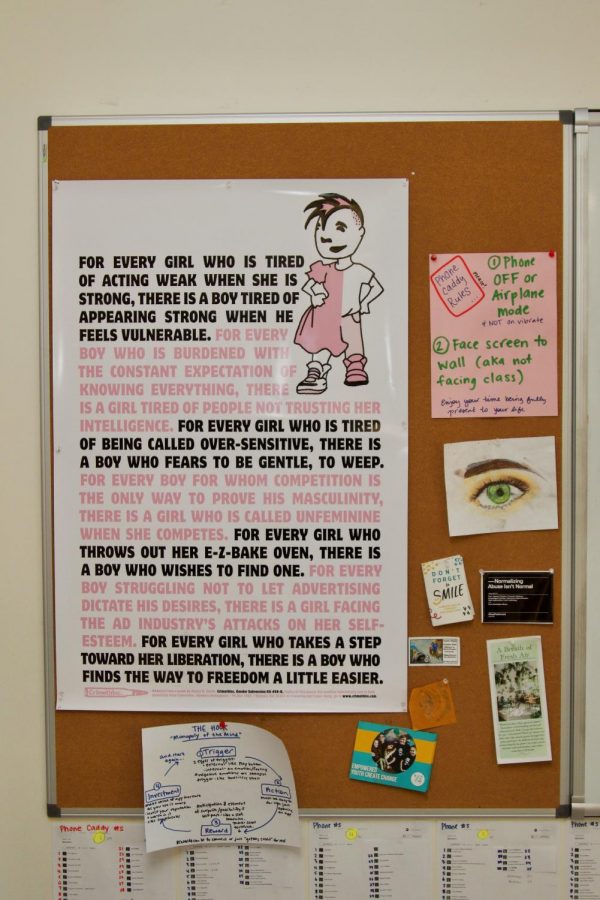Gender Roles: The Harmful Labels Put on Children
A poster addressing gender roles in health teacher Ms. Caitlin Hudson’s classroom.
December 4, 2019
Over the years, gender roles have become forced upon many generations. An invisible net that creates limitations is cast upon children. Young boys and girls, even straight from the womb, are thrown into rooms of pinks and purples, or blues and greens, usually based on their sex.
From a young age, girls are introduced to stereotypical feminine things. Dolls, princesses, and soft colors fill the rooms of baby girls. Typically, the idea of what girls should like and play with is ingrained into their heads from birth. Young girls are raised to “act like a lady” and to believe that if a boy is mean to them, it means he likes you.
Whereas, stereotypically, boys feel the pressure to “man up” and are told they are the more dominant gender. Sports such as football and wrestling are usually sports that you would imagine a boy to participate in. It is not very common to see a girls football or female wrestling team.
Gender norms inevitably exist, especially in our society today. Boys may feel uncomfortable doing things that are seen as girly, such as sharing their feelings, or showing emotion because they don’t want to be seen as weak. Likewise, girls may be criticized for being too athletic, outspoken, or demanding, since these qualities are often more tolerable in boys.
These pressures are unhealthy for children who should be encouraged to do what feels right to them and explore their interests. If a boy feels more comfortable doing traditionally “feminine” things, he should feel like he can express himself safely without judgement from others. Girls should be encouraged to find their voices, be leaders and compete along with all other athletes — regardless of their gender.
English teacher Mr. Greg Larson shared his concerns about the jokes that are said lightheartedly about gender but can leave a great impact on people. “I certainly remember people making jokes about gender issues growing up,” he said. “Saying ‘that’s for girls’ or there were a lot of jokes about homosexuality when I was a kid. Things that I would not stand by now.”
The media and movies play a large role in how gender roles are displayed. In movies, girls are often portrayed as needing to be saved by a man. Magazines are filled with women and men with impossible, airbrushed images of beauty and perfection. Women are usually shown as tall and skinny, while the men are strong and masculine. Since most children have access to technology and social media, they are often exposed to these images. They see this and feel like what they see is cool or normal for how boys and girls should act and try to look.
The media’s portrayal of beauty standards for men and women can be harmful to the mental health of people of all ages. Putting ideas into people’s heads of what is acceptable can make them feel like they do not reach society’s standards.
As companies try to sell to their audience, they advertise gender specific products. If their audience is children, there is a noticeable difference in how they are selling clothing or toys to boys or girls.
Take Halloween costumes for example. The way costumes are generally advertised to boys, is how cool they look in their costumes, and that they are out for adventure. The goal is to seem strong and like a hero.
For girls, costumes typically are princesses, or fairies, costumes that show very feminine, girly looks, which usually come with the stereotypes of being rescued by a prince.
Differently, the costumes that are advertised to girls are usually striving for girls to feel pretty, sexy or cute — accentuating their looks. Teaching girls to worry about their looks over experiencing life could cause them to feel more insecure about their bodies and what others think of them.
Sophomore Natalie Pfleger remembers her experience while growing up of the slight “push” of what is normal for a girl to play with. “My grandparents and other relatives [were] always like, ‘Oh, here’s a Barbie doll for Christmas’ and I didn’t really like that,” Pfleger said. “But I was like ‘okay, this is what I should play with’, and I never questioned it because I was like, ‘This is what a girl should play with.’ That’s what I always saw, that’s what I was always told and [what was in] movies.”
The forced roles that are put on children have a longer lasting effects than people might expect. According to the New York Times, studies show that children who play with blocks and games that require figuring out configurations have a higher chance at excelling in math and science. The children who usually play with these types of games are boys, because typically girls are given dolls and “dress up” games.
Gender stereotyping can be harmful and could leave an imprint on many people by the way they grew up or were raised. However, for girls in particular it can be harmful for them to feel like they cannot be independent, or assertive. Otherwise, people may see women as overly emotional, when a man could be showing the same emotion and be seen as bold and decisive.
These made up acceptable standards for women that are taught to young girls can be harmful. It can affect the way girls stand up for themselves, as they might not want to come off as harsh or seem like their emotions are taking over.
Teaching kids this from a young age leaves the idea in their head, unless they learn otherwise, that because they are a certain gender that they should present themselves in a certain way that seems acceptable to society. As they become adults they may have the same mindset to “stay polite” or “be strong.” This holds them back from showing emotion, or causes them to worry that people won’t take them seriously.
From early on, society has placed expectations on how people should act according to their gender. These ideas have been ingrained into the minds of people of all ages. From a young age it is taught that there is a certain way to act that would be acceptable and ways that would be preposterous to society.
It is evident through the way toys are advertised to children, and the way boys and girls are portrayed in films and the media. There can be change through society working to become more open and inclusive to all ways of life.
There are some milestones that have not been acheived, such as equal pay and gender discrimination in the workplace. Over the past years there has been more openness and fewer restrictions on what is acceptable for what a man or woman can accomplish. There is more slack if a boy wants to paint his nails or if a girl chooses to dress less feminine and more masculine.
Families and parental influences must continue to move beyond the stereotypical blue for boys and pink for girls, and move past gender discrimination when it comes to children choosing what they want to be when they grow up. Whether a girl wants to be a “masculine” firefighter, or a boy wants to be a nurse, each child should feel acceptance for being themselves. It is obvious that gender roles in society have changed over time already, but we still have many miles to cover before we reach equality.







Barb Bryan • Dec 30, 2019 at 11:13 am
I think we need to remember that much of the gender role pressure–not to mention other pressure to conform to other expectations–comes from our peers expecting us to be like them.
This is kind of “role stereotyping” that we directly influence. The rest of the basketball team, for instance, has a lot to say about what they think basketball players “should” be like. Sometimes those expectations improve the team effort and team cohesion, but sometimes they don’t. There is nothing that benefits team cohesion or class cohesion or the bond between friends, after all, like the feeling that you can be yourself and admit what you are, whether you feel proud of it or like it or you don’t.
I think the most freeing people at La Salle are those who free us to be ourselves, just as we are right now, even when we honestly have changes that even we would like to make in ourselves.